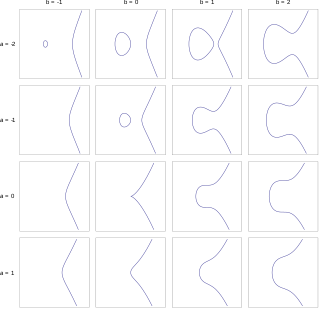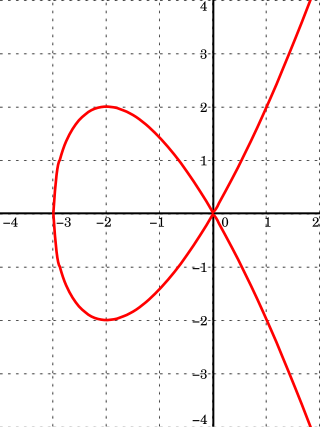
In mathematics, a Diophantine equation is an equation, typically a polynomial equation in two or more unknowns with integer coefficients, for which only integer solutions are of interest. A linear Diophantine equation equates to a constant the sum of two or more monomials, each of degree one. An exponential Diophantine equation is one in which unknowns can appear in exponents.

In mathematics, an elliptic curve is a smooth, projective, algebraic curve of genus one, on which there is a specified point O. An elliptic curve is defined over a field K and describes points in K2, the Cartesian product of K with itself. If the field's characteristic is different from 2 and 3, then the curve can be described as a plane algebraic curve which consists of solutions (x, y) for:
Catalan's conjecture (or Mihăilescu's theorem) is a theorem in number theory that was conjectured by the mathematician Eugène Charles Catalan in 1844 and proven in 2002 by Preda Mihăilescu at Paderborn University. The integers 23 and 32 are two perfect powers (that is, powers of exponent higher than one) of natural numbers whose values (8 and 9, respectively) are consecutive. The theorem states that this is the only case of two consecutive perfect powers. That is to say, that
The modularity theorem states that elliptic curves over the field of rational numbers are related to modular forms. Andrew Wiles and Richard Taylor proved the modularity theorem for semistable elliptic curves, which was enough to imply Fermat's Last Theorem. Later, a series of papers by Wiles's former students Brian Conrad, Fred Diamond and Richard Taylor, culminating in a joint paper with Christophe Breuil, extended Wiles's techniques to prove the full modularity theorem in 2001.

In mathematics, an affine algebraic plane curve is the zero set of a polynomial in two variables. A projective algebraic plane curve is the zero set in a projective plane of a homogeneous polynomial in three variables. An affine algebraic plane curve can be completed in a projective algebraic plane curve by homogenizing its defining polynomial. Conversely, a projective algebraic plane curve of homogeneous equation h(x, y, t) = 0 can be restricted to the affine algebraic plane curve of equation h(x, y, 1) = 0. These two operations are each inverse to the other; therefore, the phrase algebraic plane curve is often used without specifying explicitly whether it is the affine or the projective case that is considered.
In mathematics, a proof by infinite descent, also known as Fermat's method of descent, is a particular kind of proof by contradiction used to show that a statement cannot possibly hold for any number, by showing that if the statement were to hold for a number, then the same would be true for a smaller number, leading to an infinite descent and ultimately a contradiction. It is a method which relies on the well-ordering principle, and is often used to show that a given equation, such as a Diophantine equation, has no solutions.
In mathematics, the Birch and Swinnerton-Dyer conjecture describes the set of rational solutions to equations defining an elliptic curve. It is an open problem in the field of number theory and is widely recognized as one of the most challenging mathematical problems. It is named after mathematicians Bryan John Birch and Peter Swinnerton-Dyer, who developed the conjecture during the first half of the 1960s with the help of machine computation. As of 2024, only special cases of the conjecture have been proven.
In mathematics, the Nagell–Lutz theorem is a result in the diophantine geometry of elliptic curves, which describes rational torsion points on elliptic curves over the integers. It is named for Trygve Nagell and Élisabeth Lutz.

In mathematics, the Fermat curve is the algebraic curve in the complex projective plane defined in homogeneous coordinates (X:Y:Z) by the Fermat equation:

In number theory, a congruent number is a positive integer that is the area of a right triangle with three rational number sides. A more general definition includes all positive rational numbers with this property.
In number theory and algebraic geometry, a rational point of an algebraic variety is a point whose coordinates belong to a given field. If the field is not mentioned, the field of rational numbers is generally understood. If the field is the field of real numbers, a rational point is more commonly called a real point.

In number theory, a congruum is the difference between successive square numbers in an arithmetic progression of three squares. That is, if , , and are three square numbers that are equally spaced apart from each other, then the spacing between them, , is called a congruum.
174 is the natural number following 173 and preceding 175.
In number theory, the classical modular curve is an irreducible plane algebraic curve given by an equation
In mathematics, Hall's conjecture is an open question, as of 2015, on the differences between perfect squares and perfect cubes. It asserts that a perfect square y2 and a perfect cube x3 that are not equal must lie a substantial distance apart. This question arose from consideration of the Mordell equation in the theory of integer points on elliptic curves.

In number theory, Fermat's Last Theorem states that no three positive integers a, b, and c satisfy the equation an + bn = cn for any integer value of n greater than 2. The cases n = 1 and n = 2 have been known since antiquity to have infinitely many solutions.
In mathematics, the Mordell–Weil theorem states that for an abelian variety over a number field , the group of K-rational points of is a finitely-generated abelian group, called the Mordell–Weil group. The case with an elliptic curve and the field of rational numbers is Mordell's theorem, answering a question apparently posed by Henri Poincaré around 1901; it was proved by Louis Mordell in 1922. It is a foundational theorem of Diophantine geometry and the arithmetic of abelian varieties.

In mathematics, a stella octangula number is a figurate number based on the stella octangula, of the form n(2n2 − 1).
In mathematics, the rank of an elliptic curve is the rational Mordell–Weil rank of an elliptic curve defined over the field of rational numbers. Mordell's theorem says the group of rational points on an elliptic curve has a finite basis. This means that for any elliptic curve there is a finite subset of the rational points on the curve, from which all further rational points may be generated. If the number of rational points on a curve is infinite then some point in a finite basis must have infinite order. The number of independent basis points with infinite order is the rank of the curve.

In arithmetic and algebra the sixth power of a number n is the result of multiplying six instances of n together. So:









